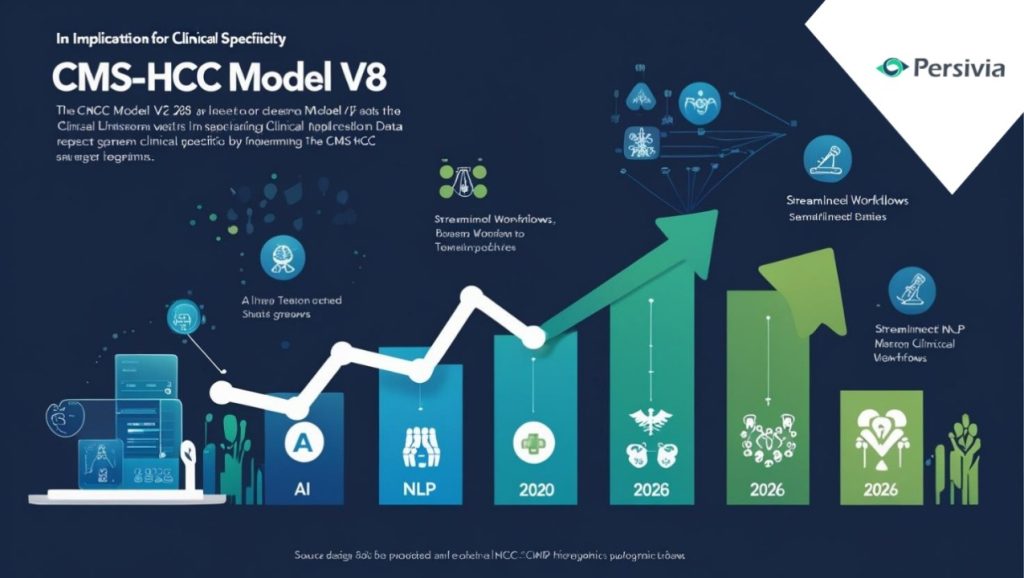CMS-HCC Model V28 demands precision. With expanded specificity, it reshapes how risk scores are calculated and forces organizations to realign clinical documentation with coding. Multi-vendor confusion, data integration issues, and coding inconsistencies are roadblocks. The good news? AI tools and Digital Health Platform integration offer a clear path forward. Businesses that embrace interoperability, organized planning, and more intelligent workflows will be most equipped to handle this change with assurance.
Healthcare organizations are aligning with a sharp regulatory shift. With the CMS-HCC Model V28, clinical documentation needs to be more specific and coding more compliant than ever. Health plans and providers must now collaborate more closely and in more detail as a result of the push for specificity. Broad-stroke diagnoses will no longer qualify under the V28 Risk Adjustment framework, making precise clinical documentation a top priority. In this environment, risk models require coding that reflects real-world complexity rather than administrative simplification.
The implications of the CMS-HCC Model V28 extend well beyond compliance. Delays in preparation put organizations at risk for workflow disruptions, audit risks, and revenue loss. It is no longer optional to have strategic alignment across platforms, people, and processes. The time has come to evaluate, modernize, and take charge of the information that determines financial performance.
The Multi-Vendor Puzzle
The operational load tied to risk adjustment is not just about codes and compliance. It’s about navigating a fragmented ecosystem of tools, workflows, and vendors. As new models like CMS HCC V28 bring higher specificity, every disconnected system adds more friction. Discussions at the forum demonstrated how important it is for businesses to eliminate inefficiencies and create platform-wide end-to-end visibility.
The challenge of fragmented systems
Healthcare organizations face a jigsaw puzzle of disconnected technologies. Executives shared how managing 30+ vendor steps from clinical documentation to CMS submission introduces risk, delays, and confusion. Each vendor operates in silos, making it hard to align processes or ensure consistency.
The solution
Reduce complexity. By combining suppliers or implementing integrated technologies that unify everything under a single interface, organizations are simplifying their IT stacks. The outcome? Stronger compliance, improved accountability, and fewer manual interventions.
Bridging Clinical Workflows and Coding Standards
Aligning clinical workflows with coding expectations has emerged as a strategic priority due to the strain of new compliance requirements. With the added specificity in CMS HCC V28, the stakes are even higher. Organizations can no longer afford disjointed communication between clinical teams and coding professionals. Bridging this gap ensures not only regulatory compliance but also accurate risk capture and better care quality.
Clinical accuracy drives compliance.
One of the biggest pain points? The disconnect between what physicians document and what coders interpret. Misalignment here leads to missed HCCs or even inaccurate risk capture.
Leading approaches include:
- Creating shared documentation protocols across clinical and coding teams
- Training on how V28 changes the diagnosis code requirements
- Embedding assistive tools into the physician workflow to guide documentation in real time
The emphasis is on precision. Under CMS HCC V28, vague or broad documentation won’t cut it.
Advancing Interoperability Across Systems
As organizations transition to more complex coding models like CMS HCC V28, interoperability becomes a strategic differentiator. A lack of clean data flow between systems can delay submissions, reduce the accuracy of risk scores, and limit the effectiveness of population health efforts. Aligning platforms, interfaces, and workflows to communicate without friction is central to operational success under evolving models.
Making data move where it matters
Timely and clean data exchange is mission-critical. Many organizations still struggle to get real-time data into the hands of decision-makers and coders.
To solve this:
- Map all data flows between systems to identify gaps
- Regularly assess integration performance
- Set up rules for quickly resolving discrepancies
- Track data exchange metrics to measure progress
When systems communicate effectively, risk scores improve, errors drop, and compliance strengthens.
Strategic moves to stay ahead
With implementation due in 2026, organizations have a tight window to prepare. The forum stressed practical steps being taken by leaders across the board.
Key strategies include:
- Rolling out incentive-based programs to boost staff engagement
- Deploying dashboards to monitor V28-specific performance indicators
- Running test scenarios that simulate new V28 workflows
- Building cross-functional readiness task forces
Structured preparation today translates to fewer surprises tomorrow.
Role of AI and NLP in Smarter Risk Adjustment
Modern risk adjustment depends on speed, accuracy, and data-driven insight. That’s why the strategic use of AI and NLP is rapidly becoming a cornerstone of success under V28 Risk Adjustment. These technologies, particularly when combined with a scalable, user-friendly system architecture, simplify documentation procedures, identify lost coding opportunities, and comprehend difficult clinical terminology. When used properly, they complement human judgment rather than take its place.
Technology fuels accuracy and speed.
V28 Risk Adjustment demands more than manual chart reviews. AI and NLP are being used to process clinical notes, uncover overlooked diagnoses, and deliver coding suggestions rooted in clinical logic.
These tools:
- Flag incomplete documentation instantly
- Suggest valid HCCs based on medical language
- Analyze patient history across multiple systems
A strong Digital Health Platform ties these elements together, driving both speed and precision.
Strengthening Trust Between Stakeholders
As organizations move toward more accountable risk models like CMS HCC V28, fostering trust across stakeholders becomes non-negotiable. Providers need visibility into how their documentation translates into coding. Payers seek consistency and accuracy in submissions. Patients deserve clarity on how their care is categorized. Without mutual trust, even the best tools can falter. Strengthening these relationships begins with shared visibility and audit-ready transparency.
Documentation done right supports everyone.
Risk adjustment works best when there’s transparency. Trust between payers, providers, and patients grows when everyone sees how diagnoses are captured and why they matter.
Trusted strategies include:
- Giving clinicians control over accepted or rejected HCCs
- Showing clearly why AI flagged a certain condition
- Using audit-friendly interfaces to back every decision with data
This is not just about compliance, it’s about empowering the entire ecosystem.
Integrating Instead of Layering
Fragmented tools and disconnected workflows create noise, not clarity. Leaders at the forum stressed how layering new technologies on top of outdated systems only amplifies complexity. As expectations around risk adjustment grow sharper under CMS HCC V28, organizations must shift focus from stacking systems to integrating them. Unified platforms simplify operations, reduce rework, and promote data integrity across departments.
Solving the multi-system chaos
Risk adjustment shouldn’t rely on patchwork systems. The forum echoed one truth loudly: integrated tools that span documentation, coding, and submission outperform cobbled-together vendor networks.
With unified platforms, organizations:
- Avoid duplicate data entry
- Improve turnaround times
- Keep all departments aligned on coding priorities
This approach supports real-time updates, especially vital when transitioning to CMS HCC V28.
Sustaining Change Through Smart Execution
Turning strategy into outcomes
Execution matters. Tools alone won’t move the needle unless they’re tied to smart processes and metrics.
Practical execution tips:
- Monitor workflow efficiency weekly
- Pilot innovations before system-wide rollout
- Get regular feedback from clinical and coding users
- Continuously adapt documentation protocols to match V28 standards
This adaptive, measurement-driven approach ensures compliance is never a one-time event.
Final Thoughts
CMS-HCC Model V28 changes the game. Healthcare organizations that invest in interoperability, data accuracy, AI tools, and smarter workflows are best positioned to adapt. Documentation needs to be intentional, specific, and traceable.
Experience Integrated Intelligence with Persivia
Healthcare doesn’t need more vendors, it needs better ones. Persivia offers Risk Adjustment Solution that empowers providers with transparent AI, NLP-backed insights, and full V24/V28 compatibility. With bidirectional EHR connectivity and a white-box AI engine, it enables clinicians to act on real opportunities without second-guessing algorithms. Learn more today.
Caroline is doing her graduation in IT from the University of South California but keens to work as a freelance blogger. She loves to write on the latest information about IoT, technology, and business. She has innovative ideas and shares her experience with her readers.




![‘Jay Kelly’ Review – Noah Baumbach Makes A Case For The Magic Of Movie Stardom [NYFF 2025] ‘Jay Kelly’ Review – Noah Baumbach Makes A Case For The Magic Of Movie Stardom [NYFF 2025]](https://cdn.geekvibesnation.com/wp-media-folder-geek-vibes-nation/wp-content/uploads/2025/11/Jay-Kelly-JKELLY_20240523_15320_C2_R-300x180.jpg)

